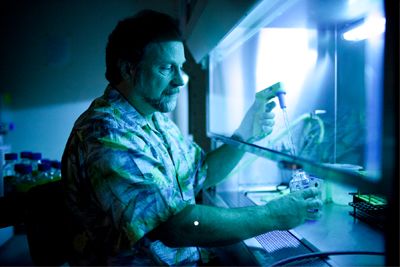
Bruce Blumberg examines cow serum tested for additives in order to figure out which type best supports the growth of fat cells.
Dr. Bruce Blumberg, Professor for the Department of Pharmaceutical Sciences at UC Irvine, and his colleagues have determined that obesogens, especially those that are environmental contaminants, are a possible explanation for the worldwide epidemic.
“Obesogens are chemicals that can inappropriately stimulate the development of fat cells or the function of fat cells. Some obesogens are found in plastics and food packaging but some are in drugs that we take. Avandia used to treat type II diabetics is an example,” Blumberg said.
During the course of Blumberg’s five-year study, eight undergraduates have contributed to the research. These individuals are Connie Chow, Star Clarke, Ryan Cubacha, Daniel Diamond, Tiffany Kieu, Nina Nguyen, Rand Relator and Zamaneh Zamarian.
Connie Chow, a fourth-year biological sciences major, and Tiffany Kieu, a fourth-year developmental and cell biology major, are the only undergraduates currently working on the project. Their work is in submission to be reviewed for publication in a journal.
Five years ago, Blumberg and his colleagues stumbled upon the idea that obesogens may cause obesity and obesity-related disorders. This occurred when they were working with Japanese collaborators in the search for compounds that inappropriately disturbed the endocrine system. Obesogens were not a part of their initial search.
“The Japanese government was interested in 20 priority compounds and they were searching for them in every body of water in Japan. We agreed to test those on their ability to act on hormone receptors. One of the chemicals was tributyltin (TBT) and we found that the receptor that activated was peroxisome proliferator activated receptor gamma (PPARγ). PPARγ is a regulator of fat cell development so that set us off on that direction,” Blumberg said. .
The science behind the biological effect of obesogens is not as complicated as it may sound.
“Obesogens activate a hormone receptor, PPARγ, and when that receptor is activated, it makes susceptible cells become fat cells and makes existing fat cells store more fat,” Blumberg said.
Blumberg and his colleagues have done a previous study showing that pregnant mice treated with TBT will have pup that become fatter when they grow up. Kieu assisted her post-doctoral supervisor, Severine Kirchner, with examining how prenatal exposure to TBT in the womb can later effect the development and function of adipose tissue in young mice. In this research, Kieu contributed most extensively to the RNA analysis
“Once treatment on the stem cells were completed and they developed into mature adipocytes, I isolated RNA from the cells and quantified the expression of adipose-specific genes using the real-time polymerase chain reaction method (real-time PCR) and a calculation called the delta-delta C(t) method. Stem cells that came from mice exposed to TBT while in the mother’s womb and/or were later treated with TBT during their maturation into adipocytes consistently expressed higher levels of adipose-specific genes than cells that were not exposed to TBT at all,” Kieu said.
Blumberg believes that adults treated with TBT will also get fatter based on the Avandia data but he has not proven that in mice yet.
Blumberg notes that there is no reason to not believe that TBT can have similar effects on adults given that existing data from pharmaceuticals back the idea that TBT will likely work the same way in adults.
Meanwhile Chow primarily assisted with the human side of the project that involved human bone marrow stem cells and human adipose derived stem cells. She gave the cells obesogens and observed how it affected their ability to differentiate into adipocytes. Her data backs the hypothesis proposed by Blumberg.
“Since the obesogens force the cells into an adipogenic line, we can see the development of fat even in cartilage or bone differentiating conditions,” Chow said.
However, Blumberg was quick to point out that it is hard to test the effects of the chemicals in adults due to the politics of the industry.
“There is an accidental trial with the diabetes drugs but you would never give people a toxic substance and look at the effects. You just cannot do those experiments. Animals are good enough to show safety but they are not good enough to show danger. That is the position of industry. Testing drugs is not the same as testing chemicals,” Blumberg said.
As a result of the politics that exist within the industry, green chemistry has recently emerged as a field that helps develop safe materials such as biodegradable plastics and cellulose-based plastics that will degrade at some frequency. Blumberg and his colleagues are working with green chemists to help them design compounds that are safe. But despite this, there are limits to the pace they can do so.
“For every unsafe compound, there is a safe alternative. But it costs money to put the alternative into practice,” Blumberg said.
With a recent ABC News report citing that 34 percent of Americans were considered clinically obese and another 33 percent were overweight, Blumberg and his colleagues believe that their study on obesogens is a socially important and timely project
“Too few people are aware that chemicals around us can actually restructure our bodies to produce excess fat. It is about helping others become healthier as a whole and giving them an opportunity to lead a more vivacious and active life. I am honored to have been a part of a project that is helping to improve the lives of others,” Kieu said.




